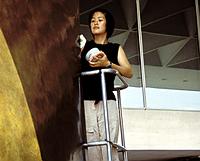Conservation of Henry Moore's Knife Edge Mirror Two Piece
Knife Edge Mirror Two Piece, by British artist Henry Moore (1898-1986), has stood outside the main entrance of the National Gallery of Art's East Building since it opened in 1978. Each summer, the staff of the National Gallery's object conservation department completes an intensive maintenance treatment that preserves the artist's vision and protects the sculpture from the detrimental effects of an outdoor environment.
A monumental bronze sculpture rising more than seventeen feet and weighing fifteen tons, Knife Edge Mirror Two Piece exhibits two of the myriad surfaces possible with bronze sculpture. While the top edge of the proper left sculptural element and the oval plane of the proper right element are highly polished, unpatinated areas, the majority of the surface has a rich brown-red patina (a colored layer produced by applying specific chemicals over the surface of the bronze).
Knife Edge Mirror Two Piece's large scale and difficult-to-reach areas (created by the curving forms) present unique challenges to the conservation team during the annual cleaning and maintenance. In order to treat every inch of the sculpture, at least six people must work a minimum of three days, using an elaborate system of mechanical lifts, scaffolding, and ladders.
Treatment of Knife Edge Mirror Two Piece begins with a thorough inspection of the sculpture. Next, the team rinses both pieces with water, using a pressure washer on a low setting. The sculpture is then washed with water and a mild, non-ionic detergent without perfumes or colorants. This step is the key to removing the dirt, pollen, and pollutants that disfigure the sculpture. Left untreated, these pollutants would eventually lead to corrosion of the metal and loss of patina. Finally, the sculpture is waxed and buffed. Applied by hand, the protective wax coating (consisting primarily of carnauba wax mixed with other natural and synthetic waxes) preserves the brown-red patina. The highly polished surfaces, however, are especially vulnerable to changes and require additional treatment. These areas are polished with an extremely fine grade of microalumina powder and coated with a synthetic resin before being waxed. The entire sculpture is buffed, both by hand and with mechanical devices.
Knife Edge Mirror Two Piece is exposed day and night to all four seasons of the year. Annual conservation and maintenance help to protect it from the elements, pollution, and vandalism, ensuring that the sculpture continues to look the way that the artist intended.





